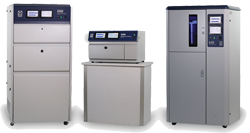【Q-LAB】
氙灯老化试验箱_盐雾试验箱_紫外光老化试验箱
咨询热线
18566398802ASTM G153-2021
ASTM G153 非金属材料曝光用密封式碳弧光仪器操作的标准实施规范
ASTM G153-2021发行信息
标准号ASTM G153-2021
中文名 非金属材料曝光用密封式碳弧光仪器操作的标准实施规范
英文名 Standard Practice for Operating Enclosed Carbon Arc Light Apparatus for Exposure of Nonmetallic Materials
发布日期2021
实施日期
废止日期无
中国标准分类号G04;Q04
国际标准分类号19.040 (Environmental testing)
发布单位US-ASTM
ASTM G153-2021适用范围
1.1''This practice covers the basic principles and operating procedures for using enclosed carbon-arc light and water apparatus intended to reproduce the weathering effects that occur when materials are exposed to sunlight (either direct or through window glass) and moisture as rain or dew in actual use. This practice is limited to the procedures for obtaining, measuring, and controlling conditions of exposure. A number of exposure procedures are listed in an appendix; however, this practice does not specify the exposure conditions best suited for the material to be tested.
NOTE 1:''Practice G151 describes performance criteria for all exposure devices that use laboratory light sources. This practice replaces Practice G23, which describes very specific designs for devices used for carbon-arc exposures. The apparatus described in Practice G23 is covered by this practice.
1.2''Test specimens are exposed to enclosed carbon arc light under controlled environmental conditions.
1.3''Specimen preparation and evaluation of the results are covered in various methods or specifications for specific materials. General guidance is given in Practice G151 and ISO 4892-1. More specific information about methods for determining the change in properties after exposure and reporting these results is described in ISO 4582.
1.4''The values stated in SI units are to be regarded as the standard.
1.5''This standard does not purport to address all of the safety concerns, if any, associated with its use. It is the responsibility of the user of this standard to establish appropriate safety, health, and environmental practices and determine the applicability of regulatory limitations prior to use.
1.5.1''Should any ozone be generated from the operation of the light source, it shall be carried away from the test specimens and operating personnel by an exhaust system.
1.6''This international standard was developed in accordance with internationally recognized principles on standardization established in the Decision on Principles for the Development of International Standards, Guides and Recommendations issued by the World Trade Organization Technical Barriers to Trade (TBT) Committee.
1.1“本规程涵盖了使用封闭式碳弧灯和水设备的基本原理和操作程序,该设备旨在再现材料在实际使用中暴露于阳光(直射或透过窗户玻璃)和雨水或露水等水分时产生的风化效应。本规程仅限于获取、测量和控制暴露条件的程序。附录中列出了许多接触程序;然而,本规程并未规定最适合待测材料的暴露条件。
注1:规程G151描述了使用实验室光源的所有曝光装置的性能标准。本规程取代了规程G23,该规程描述了用于碳弧曝光的装置的非常具体的设计。规程G23中所述的装置包括在本规程中。
1.2“试样在受控环境条件下暴露于封闭的碳弧光下。
1.3“试样制备和结果评估”包含在特定材料的各种方法或规范中。一般指南见实施规程G151和ISO 4892-1。ISO 4582中描述了关于确定暴露后性质变化和报告这些结果的方法的更多具体信息。
1.4“以国际单位制表示的数值应视为标准值。
1.5“本标准并非旨在解决与其使用相关的所有安全问题(如有)。本标准的使用者有责任在使用前建立适当的安全、健康和环境实践,并确定监管限制的适用性。
1.5.1“如果光源运行产生任何臭氧,应通过排气系统将其从试样和操作人员处带走。
1.6“本国际标准是根据世界贸易组织技术性贸易壁垒(TBT)委员会发布的《关于制定国际标准、指南和建议的原则的决定》中确立的国际公认标准化原则制定的。